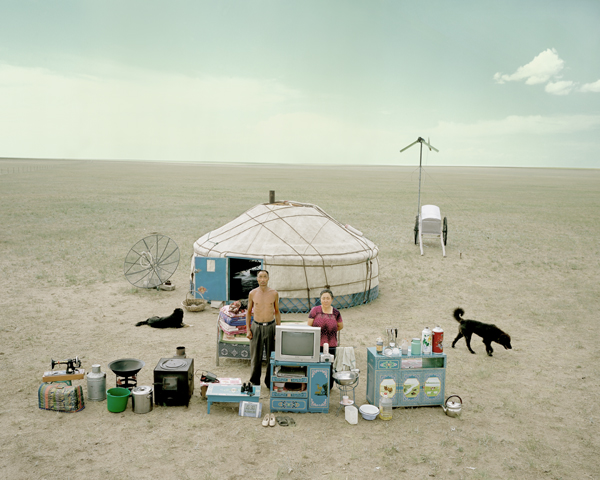By RFH
Two exhibitions opened in Beijing this weekend, both small yet worthier of a visit than many of the major ones held at, for example, the National Museum of China (unless you have a pressing interest in Louis Vuitton luggage).
Saturday saw the launch of “Art, Design, Culture: The History of Penguin by Design,” first exhibited at London’s V&A. It recounts the history of the paperback (or Penguin’s at least), which was conceived by Allen Lane in the 1930s as a way to popularize books and learning. Books had previously been seen as somewhat of a luxury item (a subject forming part of the dilemma in Orwell’s classic 1946 essay, “Books vs Cigarettes?”), and the perception then was that this was entirely just-so. Lane took the book out of the drawing room and into the railway carriages, pubs and bedsits of the country’s burgeoning middle class.
Once uniform in their orange (fiction), blue (Pelican; non-fiction) and green (crime) jackets, as the brand proliferated, so did the design and, by the 1960s, the jacket as we imagine it now – an image which speaks as much to the intended consumer as the content – was being firmly shaped. It’s worth dropping by for the huge range of talent – covers by David Pearson, Frank Gehry, Coralie Bickford‐Smith, Jillian Tamaki, and Yayoi Kusama are all on display – Penguin wielded from the 1930s until now, as well as creepy, quasi-academic paperbacks from the 1930s with such titles as The Jewish Question and Germany: What Next?
What makes “Art, Design, Culture” particularly interesting for Chinese (the exhibition also visits Hangzhou) is the parlous state of book design in China today – walk into any major outlet to see a depressingly homogenous display of covers large on characters, small on personality. But lest we get smug, this exhibition is by no means an accurate reflection of the state of book design in the UK, where Penguin is based. Most bestsellers are made through supermarkets, paid-for 3-for-2-style promotions in chains like Waterstone’s, Amazon placements, and through avowedly middle-of-the-road arbiters like the Richard and Judy Book Club. If your book doesn’t look like The Shadow of the Labyrinth Island’s Da Vinci Code, appeal to reading groups looking for the next Captain Corelli, or catch the eye of the senior buyer at Tesco’s, you can quite honestly fuck off, close down your official Twitter account and stop wasting the marketing department’s precious time.
Few (if any) of the covers at the Penguin exhibition would cut it with the sales teams at any of the Big Four. No, they’d want to “see it in yellow,” demand the lettering be more like The Time Traveler’s Wife and eventually throw the whole thing out and replace it with the cheeks and chin of a reassuringly unidentifiable female visage. The exhibition is at the Temple Hotel, which is right in the courtyard of TRB Temple Beijing; make time to see this if you’re planning to eat at TRB in the next two weeks or simply make a date to eat at Temple (it’s great!) – and don’t, for Christ’s sakes, mention e-books.
Meanwhile, I took myself up to Gulou on Sunday, where the new Yunnan restaurant Southern Barbarian was having its opening. A generous buffet, including classics like deep-fried goat’s cheese, was open to anyone who cared to wander in, as were drinks (though I’ll be returning on another occasion to properly appreciate the kitchen).
Of other interest to readers, though, is the small retrospective the restaurant is holding by photographer Huang Qingjun of his “Belongings” series, which you may have already seen online. Huang takes shots of whole families outside their homes with all their belongings heaped around. Some look proud of their swag, others quite terrified. As the blurb says: “these shots belie two decades of double-digit growth to show the bitter, hardscrabble existence suffered by most ordinary Chinese.” No question: look for the drying, bloodied goat carcasses that form the centerpiece of the Tibetan nomad household, or the house-proud couple with two dogs, TV, sewing machine and spotless set of furniture outside their yurt in the plains (top picture).
Huang, who was at the opening, reflects (in the publicity material) that the experience has taught him that “the things we require to satisfy our daily existence are few, while the things we desire are many.” Others might draw different conclusions. The notions of importance we choose to invest in material goods should be of particular resonance with the dispossessed existences of expatriates or travelers, many of whom relinquish or renew their worldly goods with each destination.
Penguin Design
When: September 2-13, noon – 9 pm daily except Thursdays (noon – 10 pm)
Address: The Temple Hotel, 23 Songzhusi, Shatan Bei Jie, Dongcheng District, Beijing 100009
Huang Qingjun: “Belongings”
When: September 2 – October 2
Address: Southern Barbarian, 107 Baochao Hutong, Gulou Dong Dajie, Dongcheng District, Beijing
Contact: southern.barbarian@yahoo.com.cn

















































